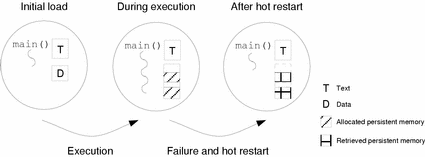Restartable Actors
A restartable actor is any actor that can be restarted rapidly without accessing stable storage, when it terminates abnormally. A restartable actor is restarted from an actor image that comprises the actor's text and initialized data regions. The actor image is stored in persistent memory (unless the actor is executed in place, in which case the actor image is the actor's executable file, stored in non-persistent, physical memory). Restartable actors can use additional blocks of persistent memory to store their own data.
Figure 3-2 shows the state of a typical restartable actor at its initialization, during execution, and once it has been hot restarted as the result of an error. The actor uses persistent memory to store state data. After hot restart, the actor is reconstructed from its actor image, also in persistent memory. It is then re-executed from its initial entry point, and can retrieve the persistent state data that has been stored.
Figure 3-2 A typical restartable actor

In the hot restart architecture, restartable actors are managed by a ChorusOS supervisor actor called the Hot Restart Controller (HR_CTRL). The HRC monitors restartable actors to detect abnormal termination and automatically take the appropriate restart action. In the context of hot restart, abnormal termination includes unrecoverable errors, such as division by zero, a segmentation fault, unresolved page fault, or invalid operation code.
Restartable actors, like traditional ChorusOS actors, can be run in either user or supervisor mode. They can be executed from the sysadm.ini file, from the C_INIT console, or spawned dynamically during system execution. The restartable nature of restartable actors remains transparent to system actors because restartable actors do not declare themselves restartable, but are run as restartable actors. More specifically, the way in which a restartable actor is initially run determines how it will be restarted when a restart occurs:
-
Restartable actors, run from the sysadm.ini file or directly from the C_INIT console, are restarted directly by the system when a restart occurs. These actors are known as direct restartable actors.
-
Restartable actors, spawned dynamically during system execution, are restarted by the actor that initially spawned them. These actors are known as indirect restartable actors.
The distinction between direct and indirect restartable actors provides a useful framework for the construction of restartable groups of actors, described in "Restart Groups".
C_INIT and the Hot Restart Controller provide an interface specifically for running and spawning restartable actors.
- © 2010, Oracle Corporation and/or its affiliates
